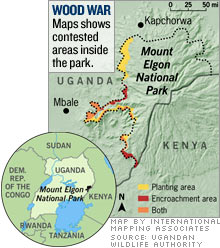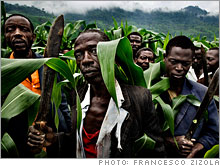The other side of carbon tradingPlanting trees in Uganda to offset greenhouse-gas emissions in Europe seemed like a good idea - until farmers were evicted from their land to make room for a forest. Fortune's Stephan Faris reports.(Fortune Magazine) -- Planting trees in Mount Elgon National Park in eastern Uganda seemed like a project that would benefit everyone. The Face Foundation, a nonprofit group established by Dutch power companies, would receive carbon credits for reforesting the park's perimeter. It would then sell the credits to airline passengers wanting to offset their emissions, reinvesting the revenues in further tree planting. The air would be cleaner, travelers would feel less guilty and Ugandans would get a larger park. But to the farmers who once lived just inside the park, the project has been anything but a boon. They have been fighting to get their land back since being evicted in the early 1990s and have pressed their case with lawsuits.

Last year, when the courts granted three border communities an injunction against the evictions, the farmers took it as permission to clear the land they consider theirs. Now a stubble of stumps - all that's left of the trees meant to absorb carbon dioxide - dots the rows of newly planted maize and budding green beans. The project in Uganda is part of a growing trade in voluntary carbon offsets, in which environmentally concerned consumers pay to have others remove an amount of carbon equal to what they emit. Vendors earn carbon credits by planting trees, which capture carbon from the atmosphere, or by modifying existing factories to consume fewer fossil fuels. Last year the worldwide market for such voluntary offsets reached $110 million, up 175 percent from 2005, according to ICF International, a Virginia consultancy that expects demand to grow to $40 billion by 2010. "It's just the takeoff point of the market," says Abyd Karmali, ICF's managing director for Europe. But with the growth in demand - HSBC (Charts), Google (Charts, Fortune 500), the World Bank, even the Super Bowl have all pledged to go carbon neutral - has come a surge of criticism. Environmentalists worry that by providing a seemingly easy fix, carbon offsets delay the structural changes needed to prevent global warming. "We can plant as many trees as we want," says Timothy Byakola of Climate and Development Initiatives, an advocacy group in Uganda, "but as long as people keep polluting as usual, keep their big vehicles, and keep consuming a lot of fossil fuels, it's not going to solve the problem." Forestry projects, which ICF estimates account for 20 percent of the market, come in for especially strong criticism, in part because it's difficult to guarantee whether the trees will be around long enough to do what the sellers of carbon credits have promised. "Trees are a very insecure and volatile way of storing carbon," says Jutta Kill of SinksWatch, a British monitoring group. In Ecuador, where the Face Foundation runs its largest project, unhappy community leaders told Kill that planting trees has cost them money. She also visited projects in Brazil and India involving land that was contested, as in Uganda. "The offset projects exasperate existing conflicts and make their resolution more difficult," Kill says, "and then the conflicts threaten the trees." "They came in broad daylight and started firing," says Ezera Wandeka, a 72-year-old farmer who once lived inside what is now Mount Elgon National Park, recalling what happened 15 years ago when Ugandan forest rangers set fire to his home and evicted him and other farmers from their land. "We could only run away." Wandeka, who keeps his land title and other documents in a charred pink folder that he rescued from the fire, went from being one of the community's richest members, a parish chief and owner of 26 cows, to one of its poorest. The forest rangers were following government orders to clear the land and ready it for reforestation. The mountainous area, which straddles the border between Uganda and Kenya, was first declared a protected area in 1938 by the British, who set the forested highlands aside as a water-catchment area. Neighboring communities were allowed to forage for bamboo, mushrooms and medicinal herbs, but timber cutting was managed by the colonial government. When the area currently under dispute was surveyed in the early 1960s, wildlife officials say, all the parkland on Mount Elgon's slopes and much of the surrounding region was forest. But the following decades were marked by explosive population growth, political chaos, and corruption. Uganda swung between dictatorships and kleptocracies, and in and out of civil war. "We lost 90 percent of our wildlife during that period," says Sam Mwandha, director of field operations for the Uganda Wildlife Authority. When the park was resurveyed in the early 1990s, large strips had been cleared for farming. The evictions that followed left a stretch of empty land running 130 miles along the park boundary, which the Face Foundation was brought in to reforest. The foundation began planting in 1994 as a way of offsetting the Dutch Electricity Generating Board's greenhouse-gas emissions and has since invested $4 million in the project, enough to pay for 3.4 million trees, about a third of what was initially planned. In 2002 the foundation turned to selling carbon credits as a way to fund its projects. But resentment over the evictions festered. "They were respecting animals rather than human beings," says Yutuko Kimareni, who chairs the Namisindwa Landowners Association, a group of 433 families seeking recognition of their claims. It wasn't until national elections last year resulted in political promises to redraw the park borders that things heated up. That's when Wandeka and his former neighbors got their injunction. And that's when the machetes started flying. More than half-a-million trees that the Face Foundation had planted were chopped down, and the conflict between the evicted farmers and the paramilitary Ugandan Wildlife Authority got ugly. Wandeka and other farmers allege beatings and torture. In March a ranger was arrested after shooting a man who had chopped at his gun and his forearm with a machete. Johnson Masereka, the park's chief warden, keeps a photograph of another ranger with hack marks on the back of his head. "That's what we face as conservationists," he says. In addition to angry farmers, his rangers fend off timber poachers inside the park, most of them locals trying to earn enough to survive. "The fact is, the population is growing, but the land we have is not elastic." Masereka maintains that his predecessors acted properly in evicting the farmers, but he acknowledges that more could have been done to bring the park's neighbors onboard. The government reinvests 20 percent of park revenues in local projects. Of his 140 rangers, 96 come from local communities. But tourism revenues for the out-of-the-way park can't make up for lost income from farming, and neither the Face Foundation nor the wildlife authority is able to hire more than a handful of full-time staff in this densely populated part of the country. "At this stage we don't get any carbon credits for this project," says Denis Slieker, director of the Face Foundation, which has stopped planting trees in the park. "We do not plan to expand anymore in Mount Elgon before these matters are resolved." However the conflict on Mount Elgon is settled, larger questions about reforestation projects remain. To its critics, tree planting essentially moves carbon naturally sequestered in oil, gas and coal deposits into wood that can burn, rot or, as in the Mount Elgon project, be chopped down. To sequester its full quota of carbon, a forest must grow for 100 years. But it's difficult to guarantee that the trees will be around long enough to do what the sellers of carbon credits have promised. The trees planted in Mount Elgon "were supposed to sink carbon," says Byakola, the Ugandan environmental activist. "But as long as the conflict exists, you are not going to be sure that those trees are going to be there the next year, or in 20 years." It's also difficult to monitor the self-regulated carbon-trading market. Last year Clean Air/Cool Planet, a U.S. environmental group, rated 30 offset providers and said it could recommend only eight of them with confidence. (The Climate Neutral Group, which markets the Face Foundation's credits, did not make the cut.) "In the absence of an accepted standard," the group's report noted, "almost anyone can offer to sell you almost anything and claim that this purchase will make you carbon neutral." None of that matters to the villagers on the slopes of Mount Elgon, where cows graze on alpine hillsides under big-leafed banana trees. They just want their farmland back. While they wait for a ruling from the courts or a decision from Parliament, they tend their seasonal crops of maize or green beans, planted for a quick harvest. But here and there, farmers have begun growing trees of their own: passion fruit, avocado, banana crops - that take years to bear fruit. It's a sign of confidence that they will be allowed to stay, and that the Face Foundation's trees will not. "Conservation cannot be done where you have isolated the people," says Masereka, the park warden. The tree planting, it seems, won't yield carbon credits until everybody feels like a winner. |
|

